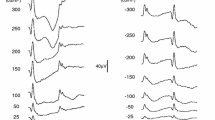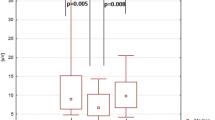Abstract
Stimulus quantities with a ramp-like temporal course evoke cortical potentials that are delayed and attenuated in comparison with responses evoked by a step-like course. This delay probably depends on temporal transfer characteristics of the activated precortical visual system. In a pilot study, luminance onset and pattern-reversal stimulation using this technique (light-emitting diode stimulator; transition time, 50 ms) were applied to 18 glaucomatous eyes with early visual field damage. The visual evoked cortical potential latency shifts between ramp and step mode were compared with visual field indices (mean defect, corrected loss variance). The pattern-reversal stimulation in ramp mode yielded a significant difference between the glaucoma group and normal subjects (p < 0.004). The difference between groups with pattern-reversal stimulation in step mode was not significant (p = 0.15). From the determined visual field indices, only the mean defect showed a significant correlation to the measured visual evoked cortical potential latency shift, with both luminance-onset and pattern-reversal stimulation. In glaucoma with early malfunction, the precortical transmission and processing of lower and middle temporal frequencies, which are predominant in ramp-like temporal stimulus courses, are obviously more affected than the transmission of higher frequencies. The ramp stimulation technique for visual evoked cortical potentials might be of interest as a tool to detect early and specific functional defects in glaucoma.
Similar content being viewed by others
References
Bodis-Wollner I, Atkin A, Podos S, Wolkstein M, Mylin L, Nitzberg S. VEP latency in ocular hyptertension and glaucoma [Abstract]. Invest Ophthalmol Vis Sci 1982; 22(suppl.): 95.
Price MJ, Drance SM, Price M, Schulzer M, Douglas GR, Tansley B. The pattern electroretinogram and visual-evoked potentials in glaucoma. Graefes Arch Clin Exp Ophthalmol 1988; 226: 542–7.
Bray LC, Mitchell KW, Howe JW. Prognostic significance of the pattern visual evoked potential in ocular hypertension. Br J Ophthalmol 1991; 75: 79–83.
Fischer FW. Schwellenangepasste überschwellige Rasterperimetrie am Goldmann-Perimeter. Klin Monatsbl Augenheilkd 1984; 185: 204–11.
Flammer J. The Octopus glaucoma G1 program. Glaucoma 1987; 9: 67–72.
Towle VL, Sokol S, Moskowitz A, Schwartz B. The visually evoked potentials in glaucoma: Effects of check size, field size and alteration rate [Abstract]. Invest Ophthalmol Vis Sci 1981; 20(suppl.): 22.
Trick GL. Retinal potentials in patients with primary open-angle glaucoma: Physiological evidence for temporal frequency tuning deficits. Invest Ophthamol Vis Sci 1985; 26: 1750–8.
Schmeisser ET, Smith TJ. Flicker VEP frequency response curves in glaucoma. Invest Ophthalmol Vis Sci 1988; 29: 239.
Bach M, Speidel-Fiaux A. Pattern electroretinogram in glaucoma and ocular hypertension. Doc Ophthalmol 1989; 73: 173–81.
Odom JV, Feghali JG, Jin J, Weinstein GW. Visual function deficits in glaucoma. Arch Ophthalmol 1990; 108: 222–7.
Author information
Authors and Affiliations
Rights and permissions
About this article
Cite this article
Mierdel, P., Zenker, HJ. & Marré, E. Cortical potentials to pattern reversal and luminance onset under ramp stimulation conditions in glaucoma. Doc Ophthalmol 80, 43–50 (1992). https://doi.org/10.1007/BF00161230
Accepted:
Issue Date:
DOI: https://doi.org/10.1007/BF00161230




